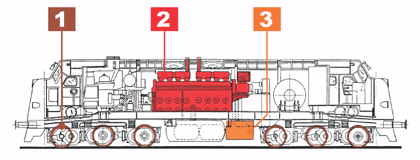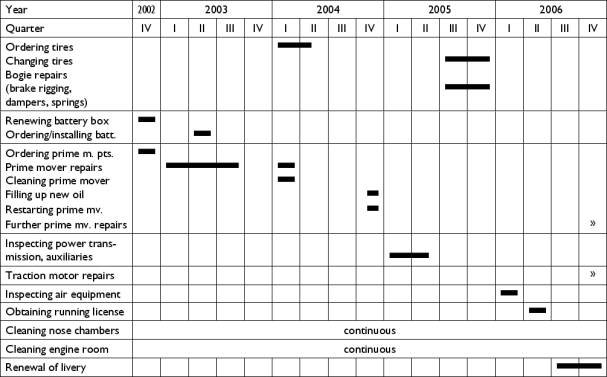|
|
| |
|
|
| |
|
| Technical Restoration | |
|
|
| |
|
|
| |
|
|
The class M61 locomotives, especially in the second half of their service life, operated under adverse maintenance conditions. From the mid-1980’s on, the locomotives were no longer scheduled for general overhaul and so parts salvaged from cannibalised units were often used instead of new replacement parts. This is also reflected in the state of M61-010 as certain repairs, without which the unit could not be preserved in an operable condition, need to be carried out. Urgent repairs  1. The most vital step in the restoration is the replacement of the
tires on all 6 axles, as they show extreme wear due to which a speed restriction of 80 km/h
had already been imposed on the
locomotive in the last months of 2000. The new tires have already been
obtained and the replacement itself will soon take place in
MÁV's “Északi” (Northern) Repair Shops who
will take over the costs of the tire replacement and associated technological
steps to support our restoration efforts.
1. The most vital step in the restoration is the replacement of the
tires on all 6 axles, as they show extreme wear due to which a speed restriction of 80 km/h
had already been imposed on the
locomotive in the last months of 2000. The new tires have already been
obtained and the replacement itself will soon take place in
MÁV's “Északi” (Northern) Repair Shops who
will take over the costs of the tire replacement and associated technological
steps to support our restoration efforts.
This step of the overhaul is furthermore a good opportunity to inspect, and repair if needed, the brake rigging and suspension springs of the bogies, as well as the air and brake systems. The latter are expected to cost several times less than the tire replacement. 2. Several compression rings, cylinder head gaskets, fuel injectors and cylinder liners needed immediate replacement. These have been either delivered as new parts (some of them free of charge from the GM-EMD representative Turner Diesel of Scotland), or – some cylinder liners and cylinder heads – renewed from used material. The first repairs to the prime mover were performed by late August 2003, with the help of former maintenance personnel of the locomotives at Tapolca depot (pictures can be seen here: 1, 2). Hereafter, the prime mover's cooling circuit was filled up with water to test leaks – revealing further problems in cylinder #12 and one of the water pumps. The repairs necessitated by the latter faults have been performed by now as well. New lubricating oil was acquired from ExxonMobil Hungary Ltd. who supported us by offering suitable oil at a reduced price. For changing the lubricating oil and preparing the cooling water, the experience of over twenty years of the former maintenance experts of the locomotive class was relied on. Finally, the prime mover was successfully restarted on 12 December 2004. 3. After withdrawal from regular service, the locomotive was not operated for over a year. Therefore, the batteries, some of which are more than ten years old, can not be used anymore. New batteries were obtained in 2003 at a reduced price from Akksi Kft. Also, the battery box was cleaned and repainted, damaged or corroded parts being replaced. After carrying out the above mentioned most urgent restoration steps, an operating license for the Hungarian railway network has to be obtained for the locomotive. The application for an operating license will be submitted to the Railroad Supervision Department of the Central Transportation Authority. Upon obtaining the licenses mentioned, excursion trains can be hauled by our locomotive. The income from these trains will be spent on further repairs/restoration of the machine. Further steps of restoration After completing the vital repairs, minor restoration steps remain which can be carried out later at the storage site of the locomotive and need far less financing. Future restoration steps are as follows:

|
|